Lipidomic Predictors of Coronary No-Reflow
Abstract
:1. Introduction
2. Materials and Methods
2.1. Study Population
2.2. Lipid Analysis
2.3. Cytokine Analysis
2.4. Data Normalization
2.5. Statistical Analysis
3. Results
3.1. Baseline Characteristics
3.2. Plasma Lipidome Alterations in the Setting of the NRP
3.3. Association of Clinical Parameters of No-Reflow with Circulating Lipids
3.4. Temporal Perturbations in Select Lipid Species
3.5. Association of Lipids with ST-Segment Resolution (STR)
3.6. Correlations between Plasma Cytokine Levels and No-Reflow-Associated Lipids
4. Discussion
5. Limitations
6. Conclusions
Supplementary Materials
Author Contributions
Funding
Institutional Review Board Statement
Informed Consent Statement
Data Availability Statement
Acknowledgments
Conflicts of Interest
References
- Gupta, S.; Gupta, M.M. No reflow phenomenon in percutaneous coronary interventions in ST-segment elevation myocardial infarction. Indian Heart J. 2016, 68, 539–551. [Google Scholar] [CrossRef] [PubMed] [Green Version]
- Reffelmann, T.; Hale, S.L.; Li, G.; Kloner, R.A. Relationship between no reflow and infarct size as influenced by the duration of ischemia and reperfusion. Am. J. Physiol. Heart Circ. Physiol. 2002, 282, H766–H772. [Google Scholar] [CrossRef] [PubMed]
- Rezkalla, S.H.; Kloner, R.A. No-Reflow Phenomenon. Circulation 2002, 105, 656–662. [Google Scholar] [CrossRef] [PubMed] [Green Version]
- Elbendary, M.A.W.; Saleh, M.A.; Sabet, S.S.; Bastawy, I. Correlation between endothelial dysfunction and occurrence of no-reflow in patients undergoing post-thrombolysis early invasive percutaneous intervention for ST-elevation myocardial infarction. Egypt Heart J. 2022, 74, 70. [Google Scholar] [CrossRef]
- Savic, L.; Mrdovic, I.; Asanin, M.; Stankovic, S.; Lasica, R.; Krljanac, G.; Rajic, D.; Simic, D. The Impact of Kidney Function on the Slow-Flow/No-Reflow Phenomenon in Patients Treated with Primary Percutaneous Coronary Intervention: Registry Analysis. J. Interv. Cardiol. 2022, 2022, 5815274. [Google Scholar] [CrossRef]
- Elkammash, A.; Sobhy, M.; Zaki, A.; Ayad, S. The association between admission hyperglycaemia and the no-reflow phenomenon in STEMI patients undergoing primary percutaneous coronary intervention. Future Healthc J. 2022, 9, 23–24. [Google Scholar] [CrossRef]
- Kaul, S.; Methner, C.; Cao, Z.; Mishra, A. Mechanisms of the “No-Reflow” Phenomenon After Acute Myocardial Infarction: Potential Role of Pericytes. JACC Basic Transl. Sci. 2022. [Google Scholar] [CrossRef]
- O’Farrell, F.M.; Mastitskaya, S.; Hammond-Haley, M.; Freitas, F.; Wah, W.R.; Attwell, D. Capillary pericytes mediate coronary no-reflow after myocardial ischaemia. Elife 2017, 6, e29280. [Google Scholar] [CrossRef]
- Tanaka, A.; Kawarabayashi, T.; Nishibori, Y.; Sano, T.; Nishida, Y.; Fukuda, D.; Shimada, K.; Yoshikawa, J. No-Reflow Phenomenon and Lesion Morphology in Patients With Acute Myocardial Infarction. Circulation 2002, 105, 2148–2152. [Google Scholar] [CrossRef] [Green Version]
- Fajar, J.K.; Heriansyah, T.; Rohman, M.S. The predictors of no reflow phenomenon after percutaneous coronary intervention in patients with ST elevation myocardial infarction: A meta-analysis. Indian Heart J. 2018, 70, S406–S418. [Google Scholar] [CrossRef]
- Gibson, C.M.; Cannon, C.P.; Daley, W.L.; Dodge, J.T.; Alexander, B.; Marble, S.J.; McCabe, C.H.; Raymond, L.; Fortin, T.; Poole, W.K.; et al. TIMI Frame Count. Circulation 1996, 93, 879–888. [Google Scholar] [CrossRef]
- Pantea-Roșan, L.R.; Bungau, S.G.; Radu, A.F.; Pantea, V.A.; Moisi, M.I.; Vesa, C.M.; Behl, T.; Nechifor, A.C.; Babes, E.E.; Stoicescu, M.; et al. A Narrative Review of the Classical and Modern Diagnostic Methods of the No-Reflow Phenomenon. Diagnostics 2022, 12, 932. [Google Scholar] [CrossRef]
- Soeda, T.; Higuma, T.; Abe, N.; Yamada, M.; Yokoyama, H.; Shibutani, S.; Ong, D.S.; Vergallo, R.; Minami, Y.; Lee, H.; et al. Morphological predictors for no reflow phenomenon after primary percutaneous coronary intervention in patients with ST-segment elevation myocardial infarction caused by plaque rupture. Eur. Heart J.-Cardiovasc. Imaging 2016, 18, 103–110. [Google Scholar] [CrossRef] [Green Version]
- Katayama, Y.; Taruya, A.; Kashiwagi, M.; Ozaki, Y.; Shiono, Y.; Tanimoto, T.; Yoshikawa, T.; Kondo, T.; Tanaka, A. No-reflow phenomenon and in vivo cholesterol crystals combined with lipid core in acute myocardial infarction. Int. J. Cardiol. Heart Vasc. 2022, 38, 100953. [Google Scholar] [CrossRef]
- Alshehry, Z.H.; Mundra, P.A.; Barlow, C.K.; Mellett, N.A.; Wong, G.; McConville, M.J.; Simes, J.; Tonkin, A.M.; Sullivan, D.R.; Barnes, E.H.; et al. Plasma Lipidomic Profiles Improve on Traditional Risk Factors for the Prediction of Cardiovascular Events in Type 2 Diabetes Mellitus. Circulation 2016, 134, 1637–1650. [Google Scholar] [CrossRef] [Green Version]
- Stegemann, C.; Pechlaner, R.; Willeit, P.; Langley, S.R.; Mangino, M.; Mayr, U.; Menni, C.; Moayyeri, A.; Santer, P.; Rungger, G.; et al. Lipidomics Profiling and Risk of Cardiovascular Disease in the Prospective Population-Based Bruneck Study. Circulation 2014, 129, 1821–1831. [Google Scholar] [CrossRef] [PubMed] [Green Version]
- Surendran, A.; Aliani, M.; Ravandi, A. Metabolomic characterization of myocardial ischemia-reperfusion injury in ST-segment elevation myocardial infarction patients undergoing percutaneous coronary intervention. Sci. Rep. 2019, 9, 11742. [Google Scholar] [CrossRef] [Green Version]
- Surendran, A.; Atefi, N.; Ismail, U.; Shah, A.; Ravandi, A. Impact of myocardial reperfusion on human plasma lipidome. iScience 2022, 25, 103828. [Google Scholar] [CrossRef]
- Weir, J.M.; Wong, G.; Barlow, C.K.; Greeve, M.A.; Kowalczyk, A.; Almasy, L.; Comuzzie, A.G.; Mahaney, M.C.; Jowett, J.B.M.; Shaw, J.; et al. Plasma lipid profiling in a large population-based cohort [S]. J. Lipid Res. 2013, 54, 2898–2908. [Google Scholar] [CrossRef] [Green Version]
- Benjamini, Y.; Hochberg, Y. Controlling the False Discovery Rate: A Practical and Powerful Approach to Multiple Testing. J. R. Stat. Soc. Ser. B Methodol. 1995, 57, 289–300. [Google Scholar] [CrossRef]
- de Lemos, J.A.; Braunwald, E. ST segment resolution as a tool for assessing the efficacy of reperfusion therapy. J. Am. Coll. Cardiol. 2001, 38, 1283–1294. [Google Scholar] [CrossRef] [Green Version]
- Jaffe, R.; Charron, T.; Puley, G.; Dick, A.; Strauss, B.H. Microvascular Obstruction and the No-Reflow Phenomenon After Percutaneous Coronary Intervention. Circulation 2008, 117, 3152–3156. [Google Scholar] [CrossRef] [Green Version]
- Dean, J.M.; Lodhi, I.J. Structural and functional roles of ether lipids. Protein Cell 2018, 9, 196–206. [Google Scholar] [CrossRef]
- Donovan, E.L.; Pettine, S.M.; Hickey, M.S.; Hamilton, K.L.; Miller, B.F. Lipidomic analysis of human plasma reveals ether-linked lipids that are elevated in morbidly obese humans compared to lean. Diabetol. Metab. Syndr. 2013, 5, 24. [Google Scholar] [CrossRef] [Green Version]
- Gür, M.; Türkoğlu, C.; Taşkın, A.; Uçar, H.; Börekçi, A.; Seker, T.; Gözükara, M.Y.; Kaypaklı, O.; Akyol, S.; Selek, S.; et al. Paraoxonase-1 activity and oxidative stress in patients with anterior ST elevation myocardial infarction undergoing primary percutaneous coronary intervention with and without no-reflow. Atherosclerosis 2014, 234, 415–420. [Google Scholar] [CrossRef]
- Ambrosio, G.; Weisman, H.F.; Mannisi, J.A.; Becker, L.C. Progressive impairment of regional myocardial perfusion after initial restoration of postischemic blood flow. Circulation 1989, 80, 1846–1861. [Google Scholar] [CrossRef] [Green Version]
- Xiang, M.; Lu, Y.; Xin, L.; Gao, J.; Shang, C.; Jiang, Z.; Lin, H.; Fang, X.; Qu, Y.; Wang, Y.; et al. Role of Oxidative Stress in Reperfusion following Myocardial Ischemia and Its Treatments. Oxid. Med. Cell Longev. 2021, 2021, 6614009. [Google Scholar] [CrossRef]
- Bolli, R.; Jeroudi, M.O.; Patel, B.S.; DuBose, C.M.; Lai, E.K.; Roberts, R.; McCay, P.B. Direct evidence that oxygen-derived free radicals contribute to postischemic myocardial dysfunction in the intact dog. Proc. Natl. Acad. Sci. USA 1989, 86, 4695–4699. [Google Scholar] [CrossRef] [Green Version]
- Sonnweber, T.; Pizzini, A.; Nairz, M.; Weiss, G.; Tancevski, I. Arachidonic Acid Metabolites in Cardiovascular and Metabolic Diseases. Int. J. Mol. Sci. 2018, 19, 3285. [Google Scholar] [CrossRef] [Green Version]
- Dennis, E.A.; Norris, P.C. Eicosanoid storm in infection and inflammation. Nat. Rev. Immunol. 2015, 15, 511–523. [Google Scholar] [CrossRef]
- Schrör, K. Prostaglandins, other eicosanoids and endothelial cells. Basic. Res. Cardiol. 1985, 80, 502–514. [Google Scholar] [CrossRef] [PubMed]
- Bojic, L.A.; McLaren, D.G.; Shah, V.; Previs, S.F.; Johns, D.G.; Castro-Perez, J.M. Lipidome of atherosclerotic plaques from hypercholesterolemic rabbits. Int. J. Mol. Sci. 2014, 15, 23283–23293. [Google Scholar] [CrossRef] [PubMed] [Green Version]
- Edsfeldt, A.; Dunér, P.; Ståhlman, M.; Mollet, I.G.; Asciutto, G.; Grufman, H.; Nitulescu, M.; Persson, A.F.; Fisher, R.M.; Melander, O.; et al. Sphingolipids Contribute to Human Atherosclerotic Plaque Inflammation. Arterioscler. Thromb. Vasc. Biol. 2016, 36, 1132–1140. [Google Scholar] [CrossRef] [PubMed] [Green Version]
- Jiang, X.-c.; Paultre, F.; Pearson, T.A.; Reed, R.G.; Francis, C.K.; Lin, M.; Berglund, L.; Tall, A.R. Plasma Sphingomyelin Level as a Risk Factor for Coronary Artery Disease. Arterioscler. Thromb. Vasc. Biol. 2000, 20, 2614–2618. [Google Scholar] [CrossRef] [Green Version]
- Tanaka, A.; Imanishi, T.; Kitabata, H.; Kubo, T.; Takarada, S.; Tanimoto, T.; Kuroi, A.; Tsujioka, H.; Ikejima, H.; Komukai, K.; et al. Lipid-rich plaque and myocardial perfusion after successful stenting in patients with non-ST-segment elevation acute coronary syndrome: An optical coherence tomography study. Eur. Heart J. 2009, 30, 1348–1355. [Google Scholar] [CrossRef] [Green Version]
- Mo, D.G.; Wang, C.S.; Liu, J.H.; Li, T. The predictive value of eosinophil levels on no-reflow in patients with STEMI following PCI: A retrospective cohort study. Sci. Rep. 2022, 12, 17862. [Google Scholar] [CrossRef]
- Rostami, A.; Tajlil, A.; Separham, A.; Sohrabi, B.; Pourafkari, L.; Roshanravan, N.; Aslanabadi, N.; Ziaee, M.; Mashayekhi, S.; Ghaffari, S. Association between Neutrophil-to-Lymphocyte Ratio and the Systemic Inflammatory Immunologic Index and the Angiographic SYNTAX Score and the TIMI Flow Grade in Acute STEMI: A Cohort Study. J. Tehran. Heart Cent. 2021, 16, 147–155. [Google Scholar] [CrossRef]
- Niccoli, G.; Lanza, G.A.; Spaziani, C.; Altamura, L.; Romagnoli, E.; Leone, A.M.; Fusco, B.; Trani, C.; Burzotta, F.; Mazzari, M.A.; et al. Baseline systemic inflammatory status and no-reflow phenomenon after percutaneous coronary angioplasty for acute myocardial infarction. Int. J. Cardiol. 2007, 117, 306–311. [Google Scholar] [CrossRef]
- Tian, M.; Yuan, Y.C.; Li, J.Y.; Gionfriddo, M.R.; Huang, R.C. Tumor necrosis factor-α and its role as a mediator in myocardial infarction: A brief review. Chronic. Dis. Transl. Med. 2015, 1, 18–26. [Google Scholar] [CrossRef] [Green Version]
- Maceyka, M.; Spiegel, S. Sphingolipid metabolites in inflammatory disease. Nature 2014, 510, 58–67. [Google Scholar] [CrossRef]
- Kim, M.Y.; Linardic, C.; Obeid, L.; Hannun, Y. Identification of sphingomyelin turnover as an effector mechanism for the action of tumor necrosis factor alpha and gamma-interferon. Specific role in cell differentiation. J. Biol. Chem. 1991, 266, 484–489. [Google Scholar] [CrossRef]
- Lecour, S.; Smith, R.M.; Woodward, B.; Opie, L.H.; Rochette, L.; Sack, M.N. Identification of a novel role for sphingolipid signaling in TNF alpha and ischemic preconditioning mediated cardioprotection. J. Mol. Cell Cardiol. 2002, 34, 509–518. [Google Scholar] [CrossRef] [Green Version]
- Dressler, K.A.; Mathias, S.; Kolesnick, R.N. Tumor necrosis factor-alpha activates the sphingomyelin signal transduction pathway in a cell-free system. Science 1992, 255, 1715–1718. [Google Scholar] [CrossRef]
- Annibali, G.; Scrocca, I.; Aranzulla, T.C.; Meliga, E.; Maiellaro, F.; Musumeci, G. "No-Reflow" Phenomenon: A Contemporary Review. J. Clin. Med. 2022, 11, 2233. [Google Scholar] [CrossRef]

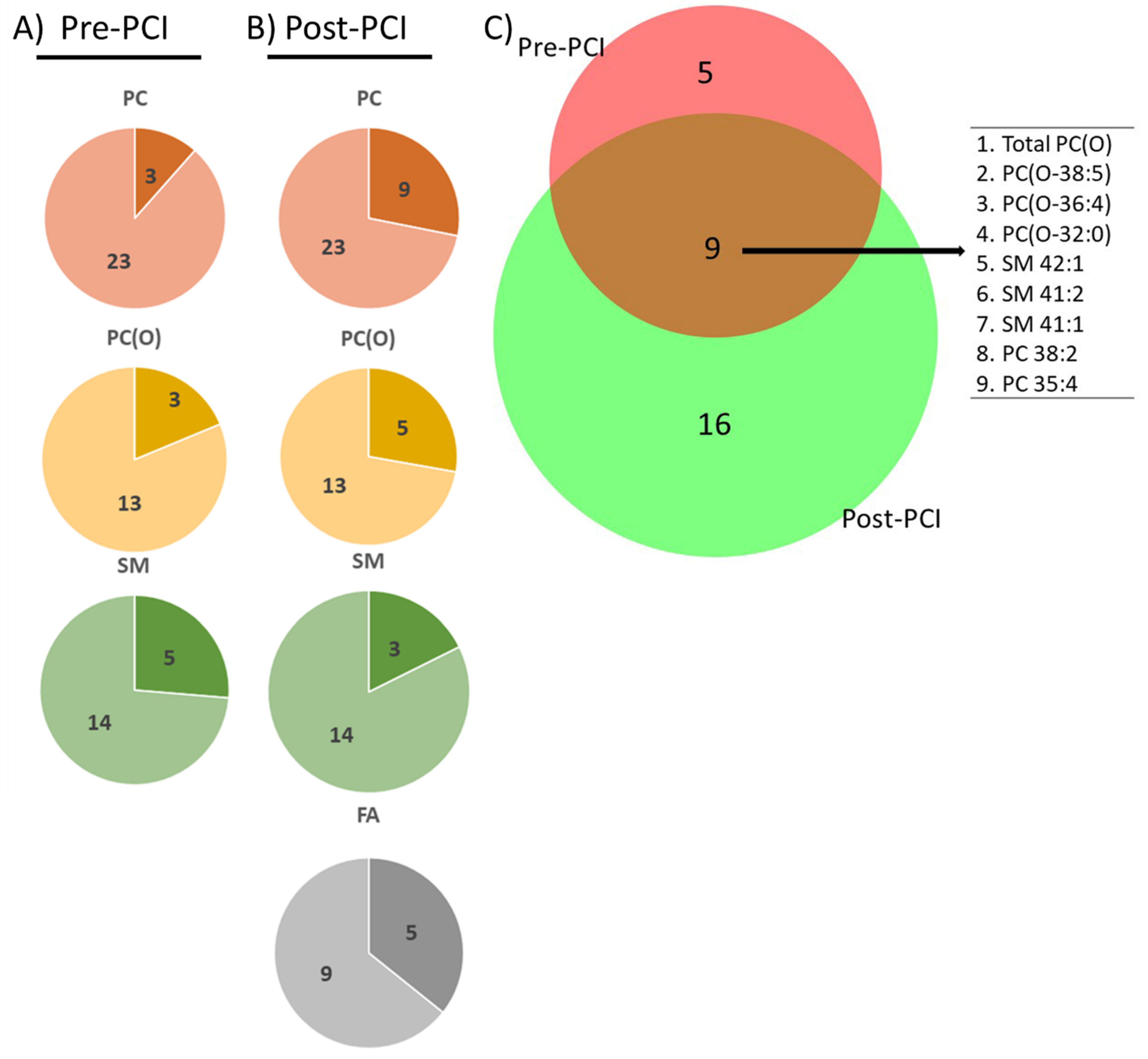
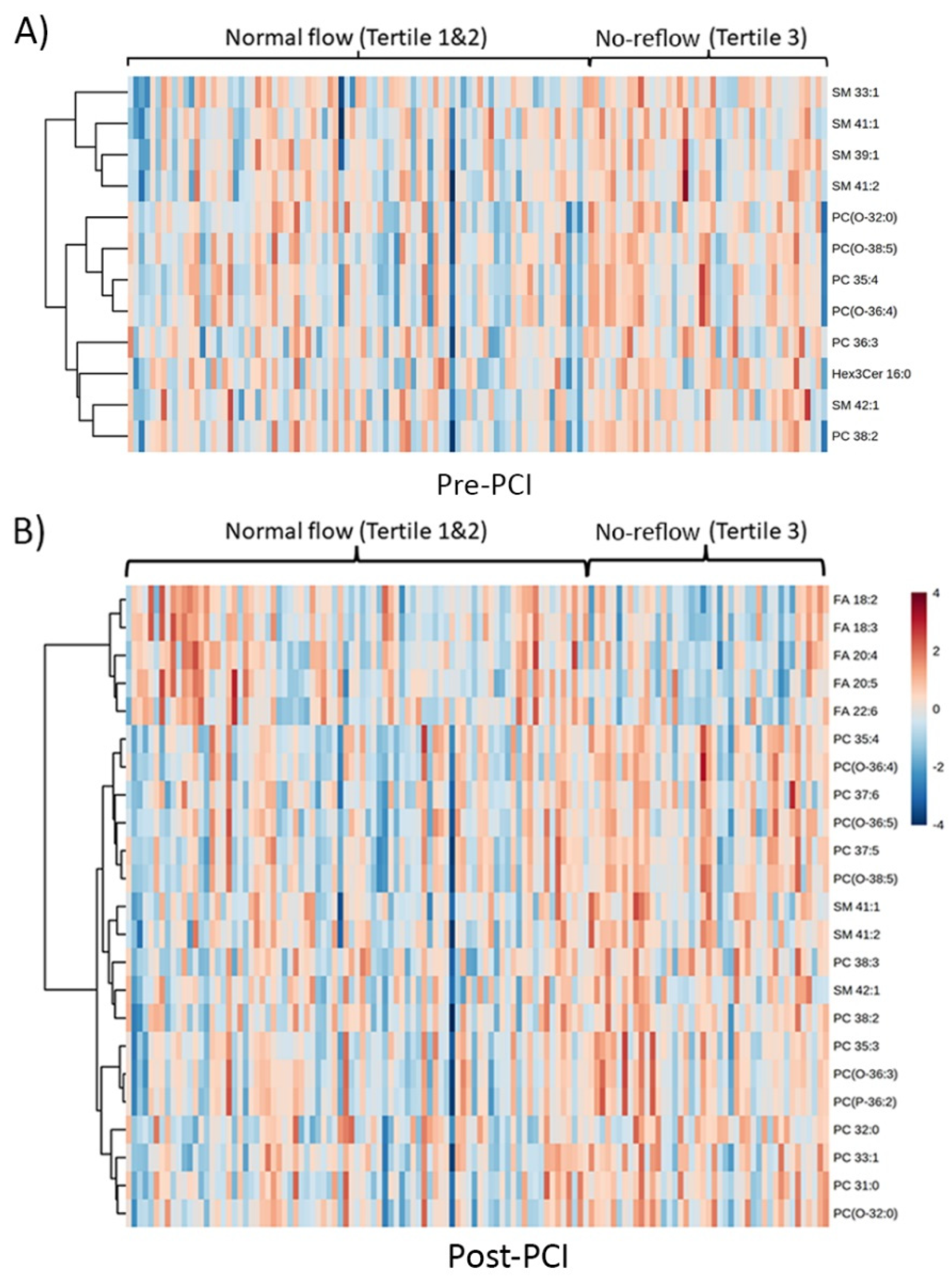
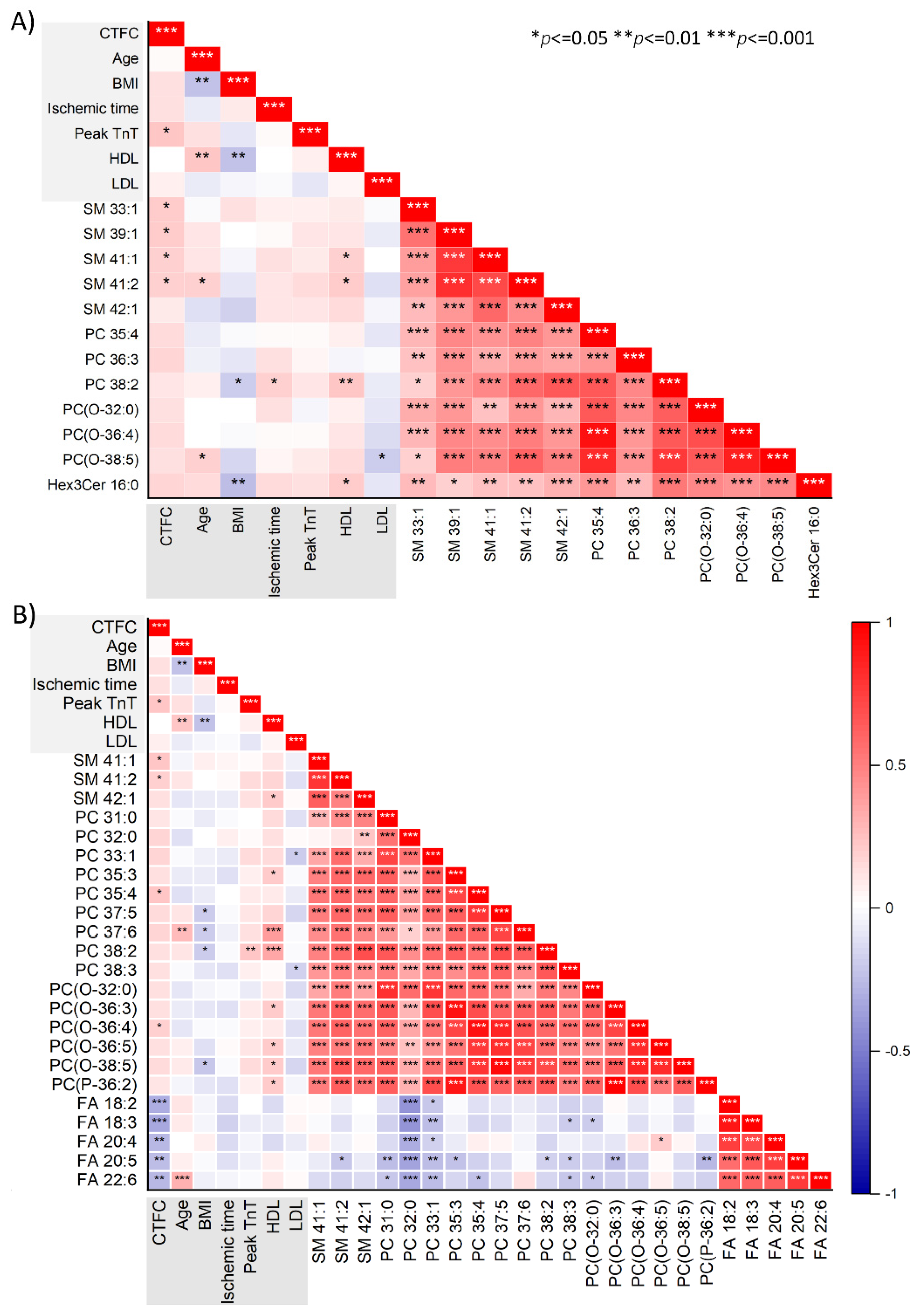
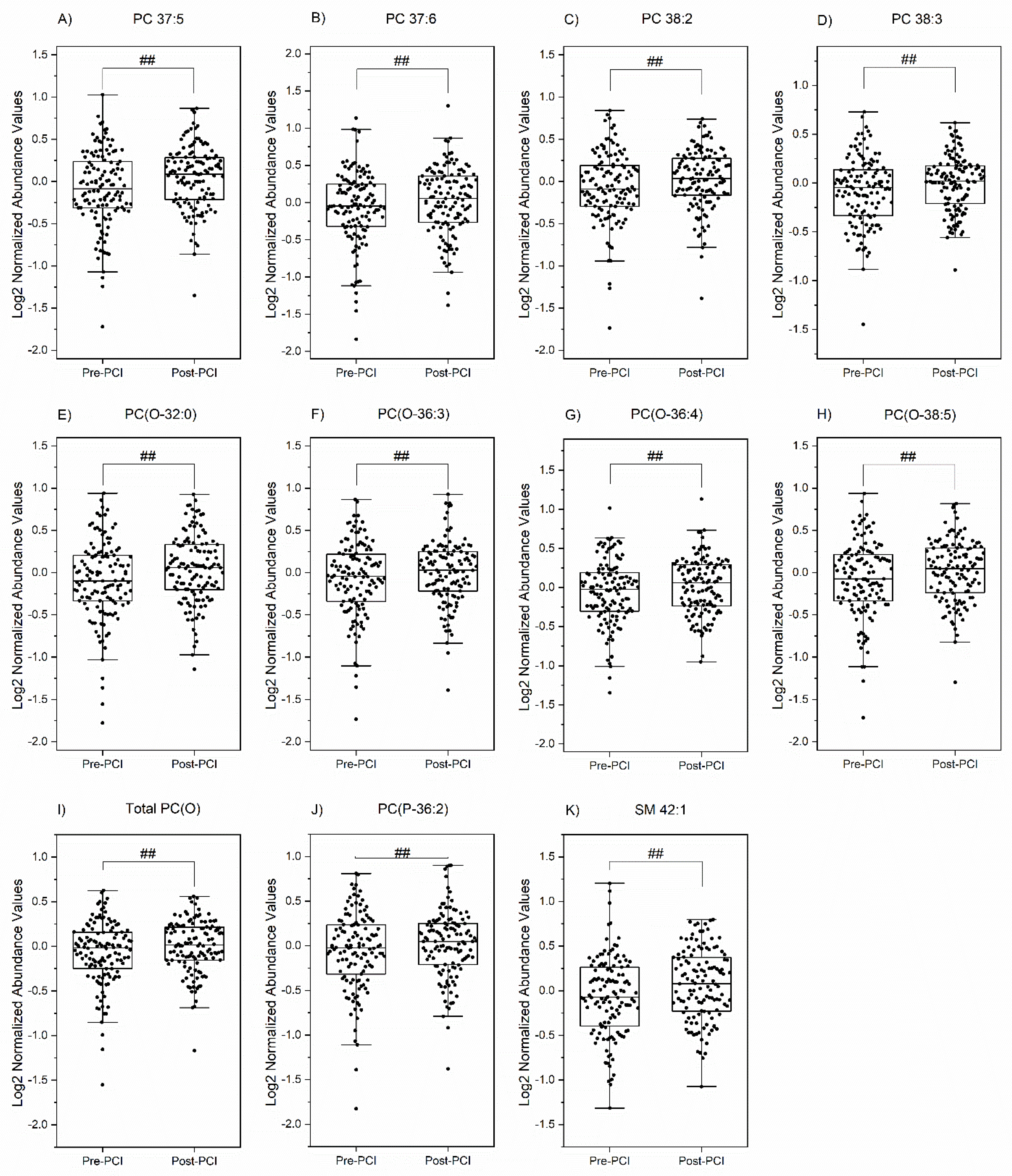
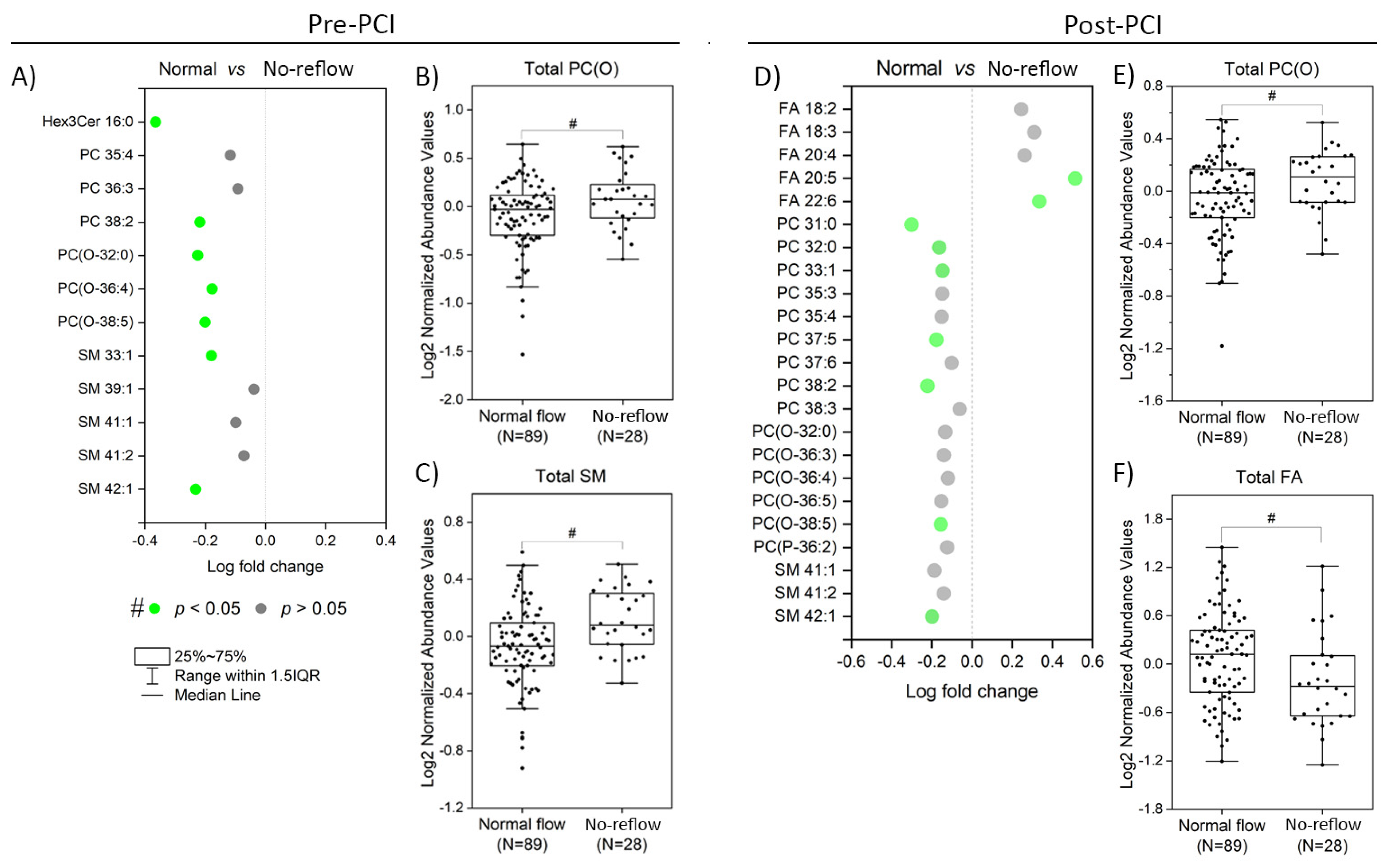
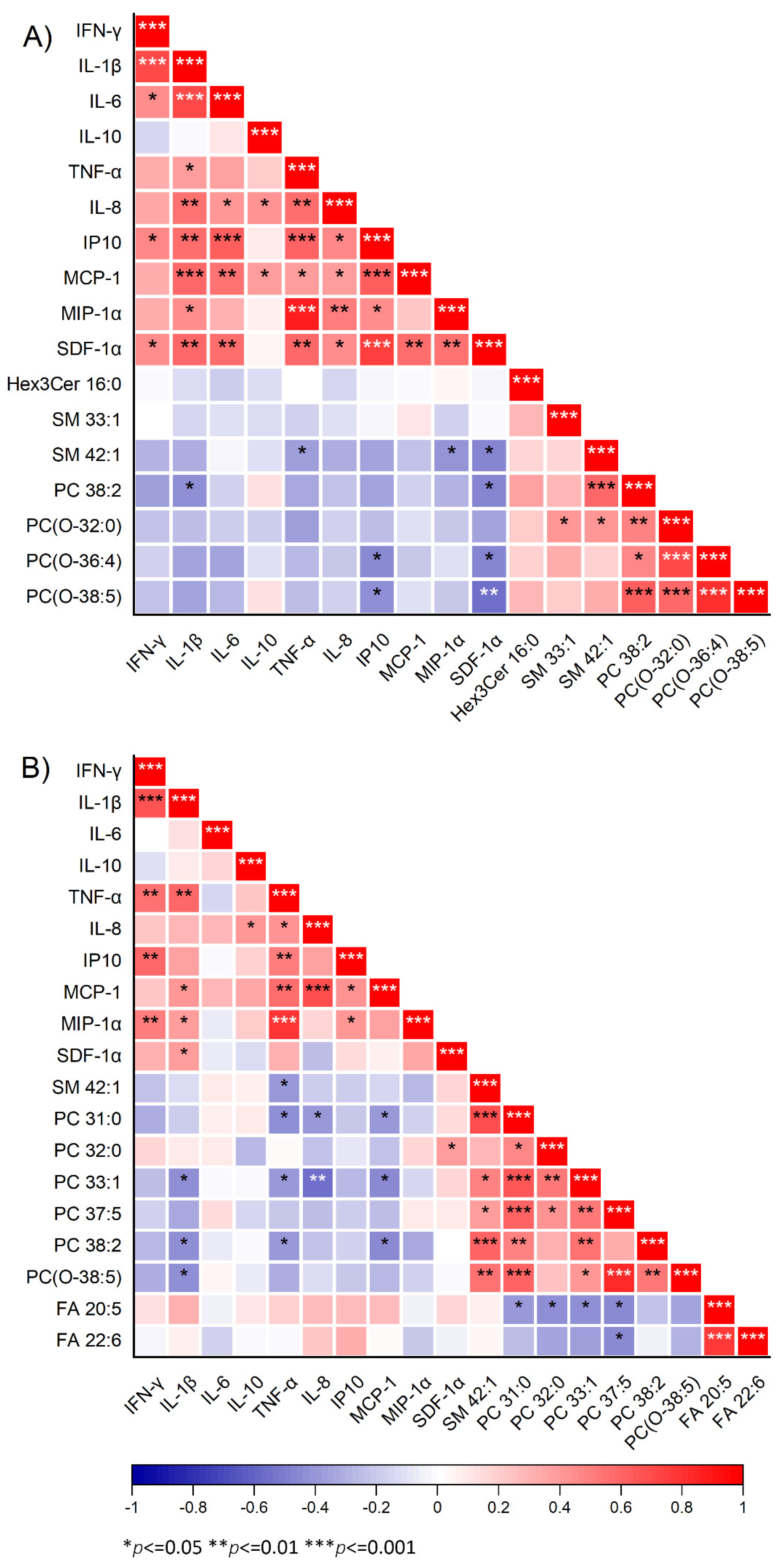
| Normal Flow | No-Reflow Flow | ||
|---|---|---|---|
| Tertile-1&2 (n = 83) | Tertile-3 (n = 43) | p Value | |
| Age (years) | 62 (51, 74) | 62 (58, 69) | 0.75 |
| Male sex (%) | 61 (73.5) | 36 (83.7) | 0.196 |
| LVEF (%) | 60 (44.7, 68.2) | 58.5 (43, 66.2) | 0.431 |
| Body mass index (kg/m2) | 27.4 (23.5, 31.2) | 28.8 (26.3, 32.8) | 0.148 |
| Comorbidity (%) | |||
| Hypertension | 29 (34.9) | 21 (48.8) | 0.131 |
| Diabetes mellitus | 17 (20.5) | 7 (16.3) | 0.569 |
| Current smoker | 29 (34.9) | 10 (23.3) | 0.179 |
| Dyslipidemia | 43 (51.8) | 17 (39.5) | 0.191 |
| Hx of CAD | 17 (20.5) | 6 (14.0) | 0.368 |
| Laboratory data | |||
| Triglyceride (mmol/L) | 1.4 (1, 2.3) | 1.2 (1, 1.9) | 0.421 |
| Cholesterol (mmol/L) | 4.58 ± 1.15 | 4.62 ± 1.16 | 0.889 |
| HDL cholesterol (mmol/L) | 1.1 (0.9, 1.4) | 1.0 (0.85, 1.3) | 0.589 |
| LDL cholesterol (mmol/L) | 2.6 (1.7, 3.3) | 2.8 (2.1, 3.5) | 0.244 |
| Creatinine (mmol/L) | 85.5 (72, 102.5) | 94 (78, 114) | 0.113 |
| Medications at baseline (%) | |||
| ASA | 21 (25.3) | 9 (20.9) | 0.585 |
| ACEI/ARB | 17 (20.5) | 11 (25.6) | 0.514 |
| Beta blocker | 10 (12) | 3 (7) | 0.375 |
| Statin | 23 (27.7) | 7 (16.3) | 0.153 |
| Additional parameters | |||
| CTFC (frames) | 20 (16, 24) | 40 (35.3, 49.4) | <0.0001 |
| Ischemic time (min) | 163 (105, 244) | 247 (125, 479) | 0.027 |
| Peak CK (Units/L) | 949 (373, 2591) | 1224 (676, 3092) | 0.213 |
| Peak TnT (ng/L) | 2259 (882, 5791) | 3575 (1229, 8689) | 0.093 |
| Culprit vessel (%) | |||
| LAD Infarct (%) | 35 (42.2) | 22 (51.2) | 0.336 |
| RCA Infarct (%) | 43 (51.8) | 12 (27.9) | 0.01 |
| Circumflex Infarct (%) | 7 (8.4) | 10 (23.3) | 0.021 |
Disclaimer/Publisher’s Note: The statements, opinions and data contained in all publications are solely those of the individual author(s) and contributor(s) and not of MDPI and/or the editor(s). MDPI and/or the editor(s) disclaim responsibility for any injury to people or property resulting from any ideas, methods, instructions or products referred to in the content. |
© 2023 by the authors. Licensee MDPI, Basel, Switzerland. This article is an open access article distributed under the terms and conditions of the Creative Commons Attribution (CC BY) license (https://creativecommons.org/licenses/by/4.0/).
Share and Cite
Surendran, A.; Ismail, U.; Atefi, N.; Bagchi, A.K.; Singal, P.K.; Shah, A.; Aliani, M.; Ravandi, A. Lipidomic Predictors of Coronary No-Reflow. Metabolites 2023, 13, 79. https://doi.org/10.3390/metabo13010079
Surendran A, Ismail U, Atefi N, Bagchi AK, Singal PK, Shah A, Aliani M, Ravandi A. Lipidomic Predictors of Coronary No-Reflow. Metabolites. 2023; 13(1):79. https://doi.org/10.3390/metabo13010079
Chicago/Turabian StyleSurendran, Arun, Umar Ismail, Negar Atefi, Ashim K. Bagchi, Pawan K. Singal, Ashish Shah, Michel Aliani, and Amir Ravandi. 2023. "Lipidomic Predictors of Coronary No-Reflow" Metabolites 13, no. 1: 79. https://doi.org/10.3390/metabo13010079








